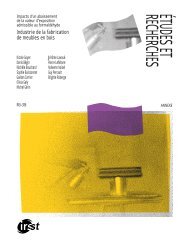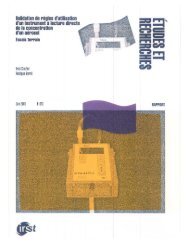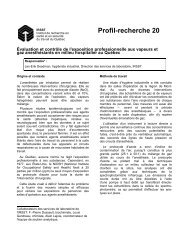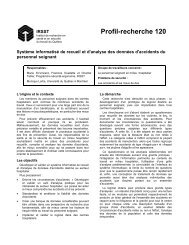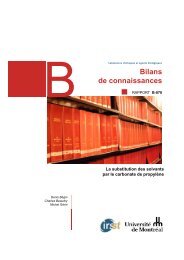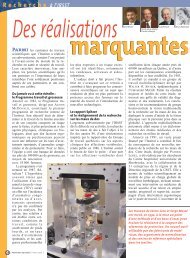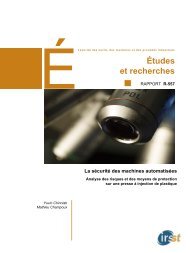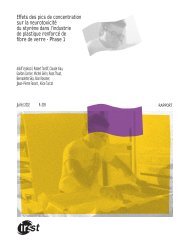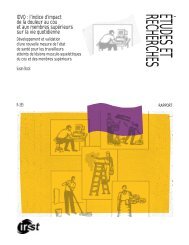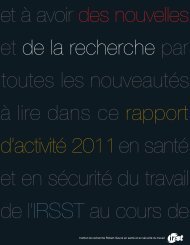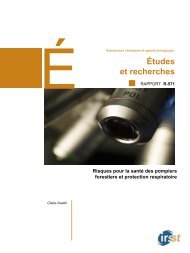Sampling Guide for Air Contaminants in the Workplace - Irsst
Sampling Guide for Air Contaminants in the Workplace - Irsst
Sampling Guide for Air Contaminants in the Workplace - Irsst
Create successful ePaper yourself
Turn your PDF publications into a flip-book with our unique Google optimized e-Paper software.
IRSST – <strong>Sampl<strong>in</strong>g</strong> <strong>Guide</strong> <strong>for</strong> <strong>Air</strong> <strong>Contam<strong>in</strong>ants</strong> <strong>in</strong> <strong>the</strong> <strong>Workplace</strong> 11<br />
similar jobs is too small. It <strong>the</strong>n becomes necessary to measure <strong>the</strong> exposure of all workers whose exposure is<br />
similar.<br />
The validity of <strong>the</strong>se group<strong>in</strong>gs based on exposure risk can be established dur<strong>in</strong>g critical studies on worker<br />
organization and from prelim<strong>in</strong>ary exposure data. The group homogeneity acceptability criterion suggested by<br />
<strong>the</strong> European community (7) is an <strong>in</strong>dividual exposure value greater than half and smaller than twice <strong>the</strong><br />
arithmetic mean of <strong>the</strong> group. For example, a group of 20 workers whose arithmetic mean of <strong>the</strong>ir exposure to<br />
a contam<strong>in</strong>ant is 1 mg/m 3 is considered as be<strong>in</strong>g homogeneous if <strong>the</strong> exposure value of each <strong>in</strong>dividual <strong>in</strong> <strong>the</strong><br />
group to this contam<strong>in</strong>ant is between 0.5 and 2.0 mg/m 3 .<br />
Table 1- Selection tables <strong>for</strong> workers <strong>in</strong> a similar exposure group<br />
Size of<br />
group<br />
Employees<br />
evaluated<br />
Table A1 – At least one worker among <strong>the</strong> 10% most exposed, probability of 90%<br />
8 9 10 11-12 13-14 15-17 18-20 21-24 25-29 30-37 38-40 40-50 51-∞<br />
7 8 9 10 11 12 13 14 15 16 17 18 22<br />
Size of<br />
group<br />
Employees<br />
evaluated<br />
Table A2 – At least one worker among <strong>the</strong> 10% most exposed, probability of 95%<br />
12 13-14 15-16 17-18 19-21 22-24 25-27 28-31 32-35 35-41 42-50 51-∞<br />
11 12 13 14 15 16 17 18 19 20 21 29<br />
Size of<br />
group<br />
Employees<br />
evaluated<br />
Table A3 – At least one worker among <strong>the</strong> 20% most exposed, probability of 90%<br />
6 7-9 10-14 15-26 27-50 51-∞<br />
5 6 7 8 9 11<br />
Size of<br />
group<br />
Employees<br />
evaluated<br />
Table A4 – At least one worker among <strong>the</strong> 20% most exposed, probability of 95%<br />
7-8 9-11 12-14 15-18 19-26 27-43 44-50 51-∞<br />
6 7 8 9 10 11 12 14<br />
1.1.5.6 Select<strong>in</strong>g representative exposure conditions<br />
Exposure evaluation conditions must be chosen so that <strong>the</strong> results provide an objective evaluation of <strong>the</strong><br />
exposure <strong>in</strong> <strong>the</strong> worker's actual task per<strong>for</strong>mance situation. In <strong>the</strong> specific case of compar<strong>in</strong>g <strong>the</strong> results of <strong>the</strong><br />
evaluation to a reference value, <strong>the</strong> conditions will also take <strong>in</strong>to account <strong>the</strong> nature of this value, namely<br />
whe<strong>the</strong>r it is a TWAEV, an STEV, a ceil<strong>in</strong>g value or an excursion limit. In addition, if <strong>the</strong> workers' work<br />
schedule differs from <strong>the</strong> typical schedule (8 hours a day, 5 days a week), <strong>the</strong> TWAEV will <strong>in</strong> some cases<br />
have to be adjusted to give an adjusted mean exposure value (AMEV). The <strong>in</strong><strong>for</strong>mation applicable to <strong>the</strong><br />
adjustment of <strong>the</strong> TWAEV and <strong>the</strong> result<strong>in</strong>g <strong>in</strong>terpretation rules are described <strong>in</strong> <strong>the</strong> <strong>Guide</strong> <strong>for</strong> <strong>the</strong> Adjustment<br />
of Permissible Exposure Values (PEVs) <strong>for</strong> Unusual Work Schedules published by <strong>the</strong> IRSST (4).<br />
The exposure must be evaluated from samples collected <strong>in</strong> <strong>the</strong> breath<strong>in</strong>g zone of <strong>the</strong> worker <strong>for</strong> <strong>the</strong> entire<br />
work period or <strong>the</strong> period provided <strong>in</strong> <strong>the</strong> appropriate reference value, namely 8 hours <strong>for</strong> a TWAEV, <strong>the</strong><br />
entire work shift <strong>for</strong> an AMEV, and 15 m<strong>in</strong>utes <strong>for</strong> an STEV. The breath<strong>in</strong>g zone is def<strong>in</strong>ed <strong>in</strong> section 1 of <strong>the</strong><br />
ROHS as:<br />
"a hemisphere hav<strong>in</strong>g a 300-mm radius extend<strong>in</strong>g <strong>in</strong> front of <strong>the</strong> face and measured from <strong>the</strong> midpo<strong>in</strong>t of



